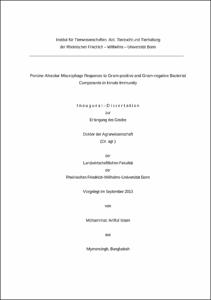Islam, Mohammad Ariful: Porcine Alveolar Macrophage Responses to Gram-positive and Gram-negative Bacterial Components in Innate Immunity. - Bonn, 2013. - Dissertation, Rheinische Friedrich-Wilhelms-Universität Bonn.
Online-Ausgabe in bonndoc: https://nbn-resolving.org/urn:nbn:de:hbz:5n-34380
Online-Ausgabe in bonndoc: https://nbn-resolving.org/urn:nbn:de:hbz:5n-34380
@phdthesis{handle:20.500.11811/5568,
urn: https://nbn-resolving.org/urn:nbn:de:hbz:5n-34380,
author = {{Mohammad Ariful Islam}},
title = {Porcine Alveolar Macrophage Responses to Gram-positive and Gram-negative Bacterial Components in Innate Immunity},
school = {Rheinische Friedrich-Wilhelms-Universität Bonn},
year = 2013,
month = dec,
volume = 169,
note = {Alveolar macrophages (AMs) are important in the regulation of innate immune responses in the lung through their phagocytosis and the production of a variety of compounds, like cytokines and nitric oxide (NO). Newborn animals are known to manifest increased susceptibility to pulmonary infection, and thus we hypothesize that this may due in part to a deficiency in the function of AMs. To dissect the age-related immune responses, AMs were isolated from 5 (newborn), 40 (post-weaned) and 120 (young) day old pigs, and stimulated with lipopolysaccharide (LPS). Cytokine mRNA and protein was assayed by quantitative real-time PCR and ELISA, respectively. We report here that AM cells were relatively less abundant in broncho-alveolar lavage fluid in newborn piglets and their phagocytic capacity to Escherichia coli was lower than those of young pigs (P<0.05). LPS inducible mRNA for TLR-4, LBP, CD-14 and MyD-88 had higher expression in newborn piglets compared with those of young pigs (P<0.05) in a time-dependent manner. The kinetics results showed that AMs from newborn piglets were significantly less capable of producing IL1-β, IL-6, IL-12β, TNF-α, IL-8 and GM-CSF than post-weaned piglets or young pigs. In contrast, IL-10 was significantly higher in newborn piglets. The reasons for differences in cytokine production may reflect maturation of immune cells which indicate functional differences of cell population and may underlay the enhanced susceptibility of early born animals to pulmonary infections. Only very low levels of NO were detected in young pigs. Future investigations in more animals and across a wider age range are recommended. Furthermore, in another study, AMs were incubated for 24 h with various concentrations of LPS, lipoteichoic acid (LTA), LPS plus LTA or control. Overall, compared to LPS, LTA was a relatively weak inducer in releasing cytokines in a dose-dependent manner. Co-stimulation augmented TLR-2, CD-14 and MyD-88 mRNA, and subsequently produced elevated levels of IL-6, TNF-α and IL-8 when compared to LPS and LTA alone. Additionally, phagocytosis of macrophages was significantly increased following low concentration of LPS treatment. Collectively, our data suggest that during pulmonary infections, an exacerbated inflammatory response may occur inducing the enhanced release of cytokines. The mechanism underlying the synergistic up-regulation of TLRs-associated genes and inflammatory cytokines by combined stimulation is of concern.},
url = {https://hdl.handle.net/20.500.11811/5568}
}
urn: https://nbn-resolving.org/urn:nbn:de:hbz:5n-34380,
author = {{Mohammad Ariful Islam}},
title = {Porcine Alveolar Macrophage Responses to Gram-positive and Gram-negative Bacterial Components in Innate Immunity},
school = {Rheinische Friedrich-Wilhelms-Universität Bonn},
year = 2013,
month = dec,
volume = 169,
note = {Alveolar macrophages (AMs) are important in the regulation of innate immune responses in the lung through their phagocytosis and the production of a variety of compounds, like cytokines and nitric oxide (NO). Newborn animals are known to manifest increased susceptibility to pulmonary infection, and thus we hypothesize that this may due in part to a deficiency in the function of AMs. To dissect the age-related immune responses, AMs were isolated from 5 (newborn), 40 (post-weaned) and 120 (young) day old pigs, and stimulated with lipopolysaccharide (LPS). Cytokine mRNA and protein was assayed by quantitative real-time PCR and ELISA, respectively. We report here that AM cells were relatively less abundant in broncho-alveolar lavage fluid in newborn piglets and their phagocytic capacity to Escherichia coli was lower than those of young pigs (P<0.05). LPS inducible mRNA for TLR-4, LBP, CD-14 and MyD-88 had higher expression in newborn piglets compared with those of young pigs (P<0.05) in a time-dependent manner. The kinetics results showed that AMs from newborn piglets were significantly less capable of producing IL1-β, IL-6, IL-12β, TNF-α, IL-8 and GM-CSF than post-weaned piglets or young pigs. In contrast, IL-10 was significantly higher in newborn piglets. The reasons for differences in cytokine production may reflect maturation of immune cells which indicate functional differences of cell population and may underlay the enhanced susceptibility of early born animals to pulmonary infections. Only very low levels of NO were detected in young pigs. Future investigations in more animals and across a wider age range are recommended. Furthermore, in another study, AMs were incubated for 24 h with various concentrations of LPS, lipoteichoic acid (LTA), LPS plus LTA or control. Overall, compared to LPS, LTA was a relatively weak inducer in releasing cytokines in a dose-dependent manner. Co-stimulation augmented TLR-2, CD-14 and MyD-88 mRNA, and subsequently produced elevated levels of IL-6, TNF-α and IL-8 when compared to LPS and LTA alone. Additionally, phagocytosis of macrophages was significantly increased following low concentration of LPS treatment. Collectively, our data suggest that during pulmonary infections, an exacerbated inflammatory response may occur inducing the enhanced release of cytokines. The mechanism underlying the synergistic up-regulation of TLRs-associated genes and inflammatory cytokines by combined stimulation is of concern.},
url = {https://hdl.handle.net/20.500.11811/5568}
}






